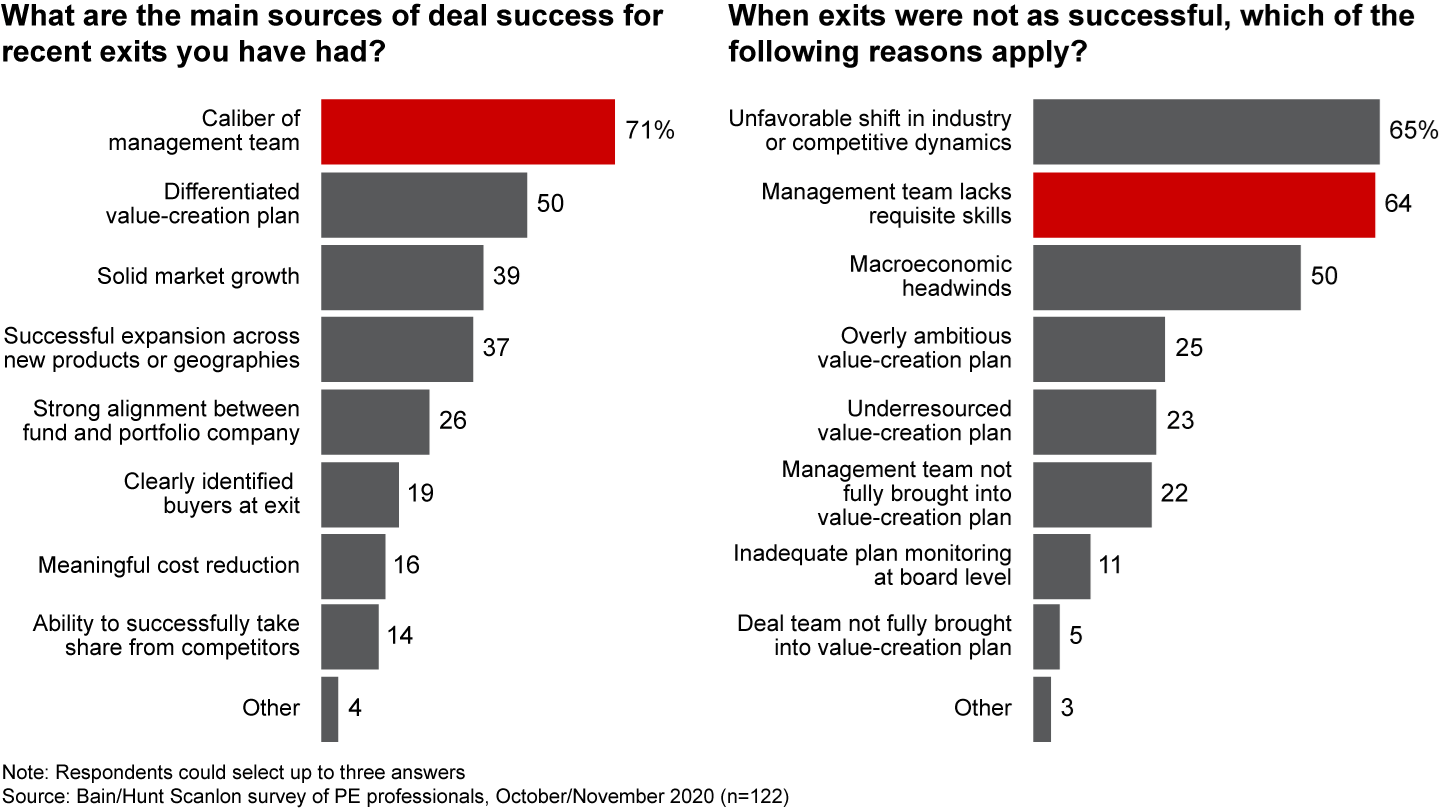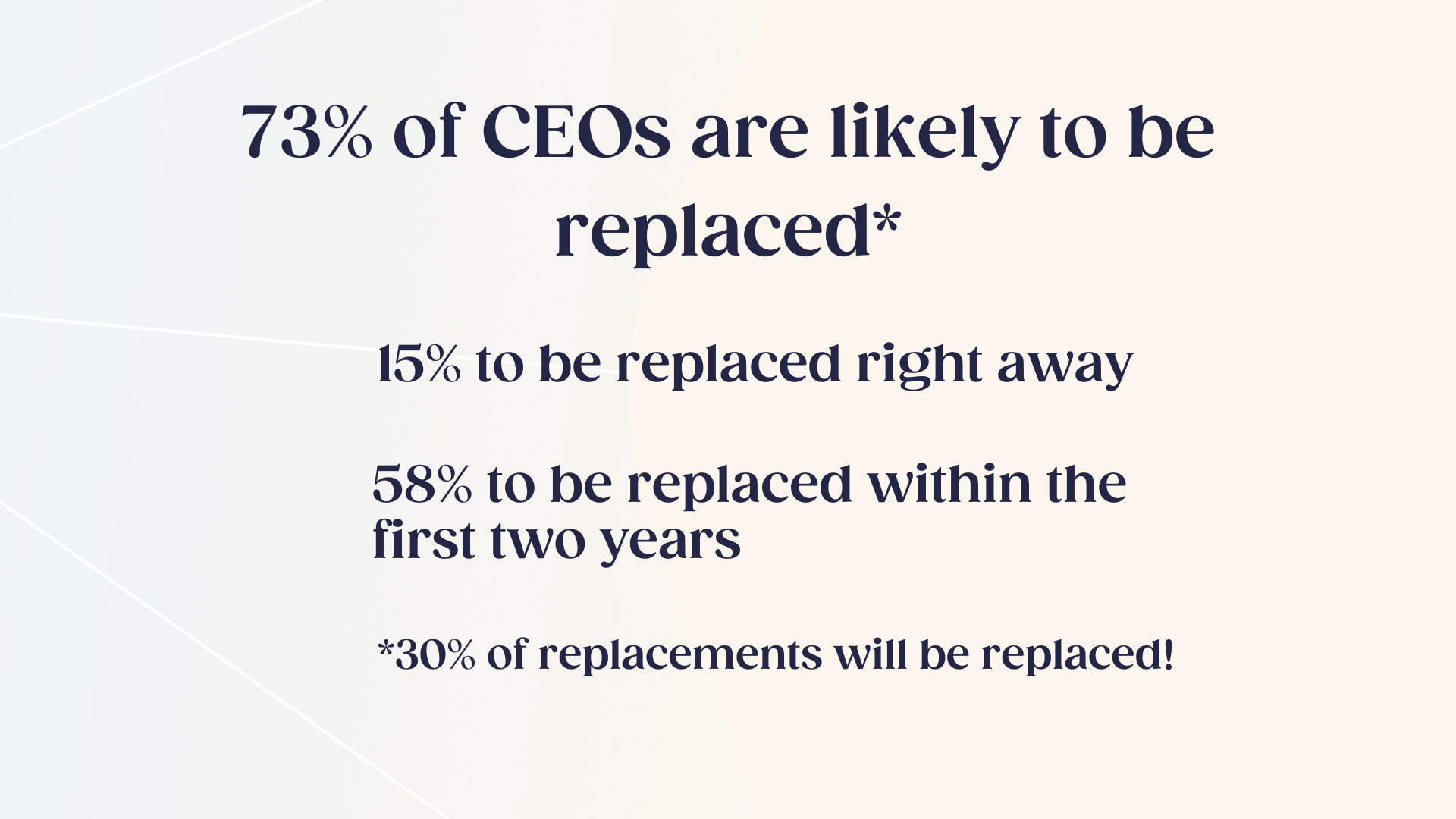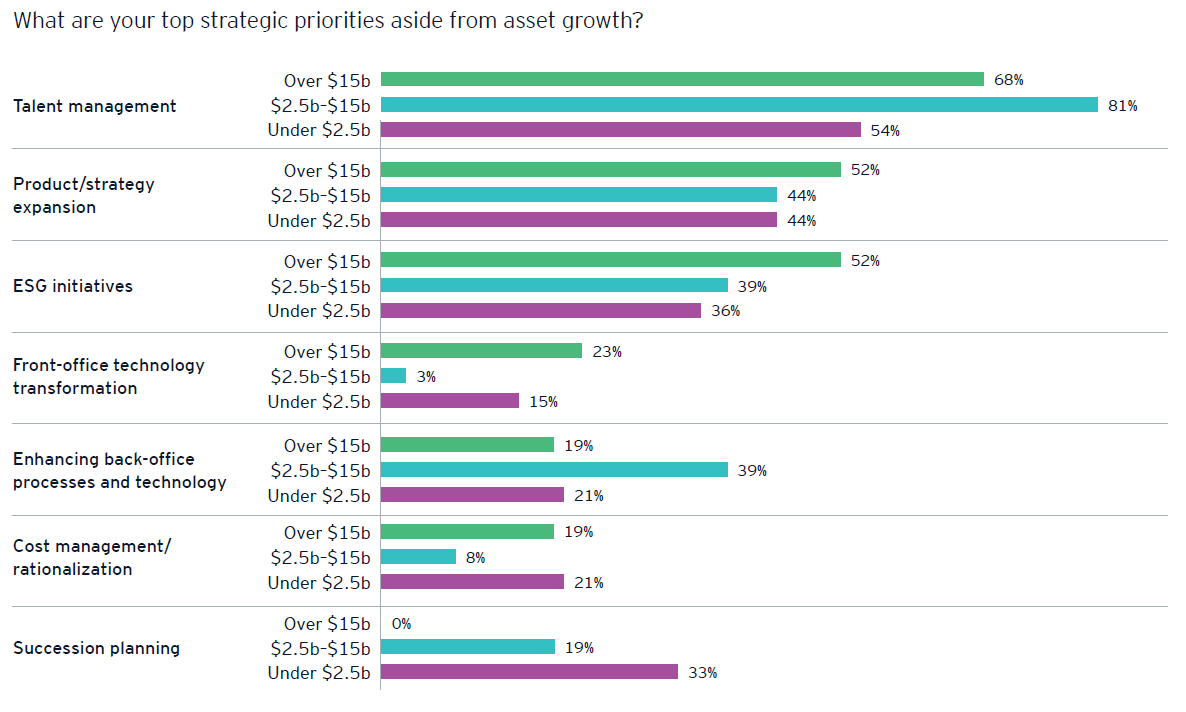How talent decisions impact private equity portfolio performance
Ott Niggulis
Getting talent decisions right is one of private equity firms' hardest challenges. They often struggle to put the right people in the right roles fast enough to have an effect on portfolio company value.
This need for speed often leads to costly hiring mistakes. The cost of replacing a senior leader can be up to 15 times the annual salary. Considering the hiring cost, earned salary, lost opportunity cost, missed revenue, etc. Not to mention indirect costs to the fund performance with longer hold times and diminished returns.
In fact, research has found that portfolio company leadership has a 15% impact on financial performance and a 30% impact on market valuation. These numbers put a lot of pressure on private equity firms to get the talent equation right.
Backed by extensive research data and example use cases, this article delves deeply into the hiring challenges private equity firms face and solutions to overcome them.
Portfolio company leadership has a 15% impact on financial performance and a 30% impact on market valuation.
The CEO problem

Image credit - Bain & Company
The talent challenges of a private-equity-backed company start from the very top. When compared to a typical CEO, the role of a private equity CEO is quite different.
In private equity, the new owners typically have an investment thesis and a strict timeline that the CEO needs to fulfil. The job of the CEO is to execute a plan that makes the thesis happen in the predetermined timeline. The job is more focused on operations, execution, and, most of all, growth.
“If you were to look at both private equity firms and public companies and you identified the ones that have outsized returns, I suspect the returns would have been driven far more by the people than by the actual products or services.”
Alan Guarino
Vice Chairman, CEO and Board Services, Korn Ferry
The skills and experiences needed to succeed at this new stage don't always align with what got the company thus far.
Therefore, it shouldn’t be surprising that most CEOs of private equity-held companies will likely be replaced during the hold period. In fact, data from AlixPartners shows that an astonishing 73% of CEOs are likely to be replaced during the investment life cycle.
Of those replacements, 58% happened within the first two years, with only 15% of CEOs being replaced from the beginning.

As with everything else in private equity, timing is everything. In general, the quicker you can get the right team in place, the better your results will be. Still, replacing a CEO or other members of the C-suite is never an easy task. But timing it right plays a crucial role in investment ROI.
Research shows that replacing a portfolio company CEO after one year of investment and within a year of an exit brings the most disruption to the organisation. Yet, 58% of CEO replacements are made precisely within that time frame. As in, the replacements are made during the worst possible time.
30% of newly hired CEOs will be replaced during the hold period.
Now, even if everything goes according to plan and the CEO replacement is made at the "right" time, that still leaves the question of if the new CEO will fit into the existing team and hit the ground running.
Research indicates that ⅓ of the time, that might not be the case - 30% of newly hired CEOs will be replaced during the hold period.
The perils of hiring
Take the example of a company in the packing industry. After being acquired, it quickly became apparent that they needed new sales leadership to expand national accounts aggressively. The company promptly hired an accomplished industry veteran with a strong track record of increasing sales.
What the new owners and the company hadn’t considered was how the new hire would fit into the existing team and their leadership style gel with the organisation.
The new hire had a hard-driving, command-and-control style which had worked well for him in his previous roles. But that same style alienated sales reps who grew up in a highly decentralised, entrepreneurial organisation. The mismatch ultimately threatened to derail the entire deal.
The example above perfectly illustrates how challenging getting talent right can be. Research from AlixPartners reveals that challenges connected to talent even outrank strategy execution timelines, market volatility, and supply chain issues:

Source: AlixPartners Seventh Annual Private Equity (PE) Leadership Survey
And a Bain/Hunt survey adds that 92% of deal teams said that waiting too long to take action on talent issues had resulted in portfolio company underperformance over the past five years. The kicker? Almost 70% indicated that this had happened in at least half of their deals!
The problem is made worse by the fact that many, if not most, private equity investors are not trained hiring experts. Furthermore, most deal and operating partners overestimate their prowess in assessing and judging talent.
92% of deal teams said that waiting too long to take action on talent issues had resulted in portfolio company underperformance.
Thankfully, private equity firms are coming around to understanding that getting talent right is crucial and also that it is hard.
Data from Ernst & Young’s 2022 Global Private Equity Report shows that, besides asset growth, the number one strategic priority for private equity firms is talent management. And of the broader talent management focus, fund managers ranked hiring and onboarding talent as an extremely important priority:

Top priorities of private equity firms besides asset growth. Image credit - Ernst & Young
And firms are investing big - 43% of the largest private equity firms say that their investments in the management function have increased significantly during the last year. In contrast, the numbers for mid-sized and smaller companies were 19% and 23%, respectively.
These data show that firms are well aware that talent is critical to deal success. What they lack are consistent and repeatable processes for analysing and hiring talent. And so, questions remain about how to achieve consistent results, how to measure what works, and how to build a repeatable process.
What are the best firms doing differently?
High-performing private equity teams understand value creation is primarily about talent, teamwork, and a high-performance culture.
On average, they spend 1.5 to 2 times more on leadership and organisational initiatives and see triple or quadruple the payback.
Moreover, 80% of talent-centric portfolio companies hit their first-year targets and achieved 2.5 times the return on the initial investment.
They achieve these results by taking due diligence into talent as seriously as financial, operational, IT, and other major value drivers.
When making investment decisions, they focus on the (financial) numbers and growth opportunities and look into the team that is expected to make it work.
80% of talent-centric portfolio companies hit their first-year targets and achieved 2.5 times the return on the initial investment.
Take, for example, the experience of Frazier Healthcare Partners, who were considering buying a publicly traded company with a price well in line with recent deals in the sector and growth projections that looked promising. But the firm’s view of the deal changed after its human capital team completed their work.
Their analysis showed that the costs associated with changing the organisational design, setting up new support functions, and recruiting additional talent, among other issues, would put the deal’s projected returns at risk. Because of these factors, Frazier put in a less aggressive bid, and the seller passed.
The value creation plan is the talent plan
There are many possible reasons why talent decisions or whole investments go awry. But firms with the highest success rates have something in common - they are highly disciplined in linking talent decisions to the explicit requirements in the value creation plan.
The plan includes value-creation strategies essential to generating attractive returns. Next, these strategies are mapped to the key roles explicitly linked to those strategies with clear and measurable objectives for each role.
That information then leads to precise job descriptions that spell out the unique experiences, capabilities and motivations required for success.
Firms with the highest success rates are highly disciplined in linking talent decisions to the explicit requirements in the value creation plan.
Next, the job descriptions and other data are used to understand if the current leadership covers all the roles in the value creation plan and if their competencies, skills, and behaviours match the roles' requirements. The latter through the use of some type of leadership assessment.
Assessing the leadership
Traditionally, firms have used outside consultants and leadership assessments that involve individual team members taking some type of psychological test(s) and, frequently, a detailed interview with a leadership assessment professional for these kinds of assessments.
This process can work, but the downside is that the quality of the outcome is determined by the consultant(s) the firms use. The firms themselves cannot guarantee consistency.
And although a lot of talent data is generated throughout this process, it is often proprietary to the consultant(s) and cannot be used elsewhere.
Even if the firms could legally use the collected talent data, it is mainly in a format that cannot be easily used in any kind of analysis. This is because consultants often manually compile these data into a digestible format, with the result being a PDF report.
“Talent, after all, is one of the biggest influences on a private equity firm’s performance, whether it’s the deal team evaluating an investment or the management team at a portfolio company.”
Dan Kaplan
Senior Client Partner at Korn Ferry’s Chief Human Resources Officers
Another pain that the traditional executive assessment has trouble solving is understanding how a candidate would fit into the existing team. Remember the sales executive from earlier?
On paper, he was the perfect candidate with years of relevant experience. And even if some psychological tests were used, all they would have shown were insights into his command-and-control leadership style. It would not have shown that his leadership style would alienate sales reps and ultimately threaten to derail the deal.
Owning your talent data is a long-term investment
Understanding that there is a problem, firms have slowly started to invest to raise their talent game by partnering with executive search firms and adding one or two portfolio talent professionals to help assess and build management teams.
The best firms, the ones seeing outsized returns, have invested heavily into building out their portfolio talent function. Having their own teams in place ensures that they can use a process that is consistent, brings results, and is repeatable across their portfolio of companies.
Additionally, having full control over the process allows them to use the collected talent and accompanying employee and candidate data to build repeatable playbooks that can be used throughout their portfolio.
The best firms, the ones seeing outsized returns, have invested heavily into building out their portfolio talent function. Having their own teams in place ensures that they can use a process that is consistent, brings results, and is repeatable across their portfolio of companies.
In short, they use interactive platforms like Wisnio. The individual assessment takes just 25 minutes to complete, which, in our experience, provides a good balance of robustness of the insight and the time it takes for business leaders to complete. That’s a fraction of the time it usually takes to go through a leadership assessment process.
Additionally, the platform looks at individual team members, analyses what happens when these individuals form a team and gives data-based suggestions to ensure a good working relationship.
With Wisnio, the value creation team gets a robust overview of the most important characteristics of the leadership team in less than 30 minutes.
This means that business leaders and the value creation team can start the discussion around their talent strategy immediately and do not need to wait for weeks for the traditional leadership assessment process to finish.
The 25 minutes it takes to complete the individual assessment is a good balance between the robustness of the insight and the time it takes for business leaders to complete it.
Example use case - post-deal leadership assessment
A major global private equity firm specialising in mid-market growth investments uses Wisnio for post-deal leadership assessment with all their new portfolio companies. With Wisnio they:
- Conduct a workshop with the leadership and investment teams to identify critical talent gaps with the available talent data and insights;
- Create a leadership development plan for critical competencies;
- Set clear key objectives and build scorecards for hiring into pivotal roles.
As a result, they:
- Get a robust understanding of the team right after post-investment instead of waiting for several weeks for a traditional leadership assessment process to finish;
- Genuinely conduct a whole team leadership assessment. Not just assess the CEO and CFO.
- Actionable insights available immediately after the process has been completed for the leadership and operating teams.
Example use case - supporting founders with critical C-level hiring decisions
A major growth-stage VC investor uses Wisnio to support founders with critical C-level hiring decisions. The fund has identified that C-level hiring significantly slows portfolio company progress post-investment.
The situation is especially bad post-series-A and -B when founder-led businesses have to start building experienced executive teams. Founders typically do not know the roles and are not great at interviewing, especially interviewing executives. This leads to poor success rates - estimated to be at 50% of all new executive hires.
To help solve the problem, the VC talent team uses Wisnio to map the leadership team of each of their investments and:
- Review the team data to identify critical competencies, behaviours, and values of the leadership team to use as a benchmark for evaluating candidates;
- Together with experts in their network and their executive search partners, they built hiring scorecards and detailed interview and evaluation guides for critical C-level roles, which are now used as a starting point to help founders hire more systematically;
- Use the collected talent data across their portfolio to systematically analyse high-performers in pivotal C-level roles and refine their hiring guides and scorecards based on the insights.
As a result:
- The executive search partners get a clear and systematic brief from founders quickly. This enables them to present a shortlist four weeks faster;
- Portfolio companies reduced the number of interviews to a maximum of 3-4 structured and well-prepared interview rounds;
- Hiring managers who follow the scorecard and systematic process typically achieve over 80% ratio of candidates who meet or exceed expectations 6-12 months post-hire, which is a remarkable improvement over the typical 50-60% hiring success rate.
Conclusions
Value creation in private equity happens through many different mechanisms, but ultimately it is driven by people.
Not only can CEO and other senior leadership turnover lead to confusion and fears of what will happen to me among leadership and employees, it’s also a leading reason for smaller investor internal rates of return (IRR), lengthening of hold times, and even investments outright failing.
Research has shown that the leadership team of a portfolio company has a 15% impact on financial performance and a 30% impact on market valuation. Get it right, and you just earned a third more money. Get it wrong, and you just lost a third.
Firms that understand this spend 1.5 to 2 times more on leadership and organisational initiatives and see triple or quadruple the payback.
They invest heavily into building out their portfolio talent function. And as a result, they have a consistent, repeatable process that brings results and can be used across their portfolio of companies. Are you doing the same?